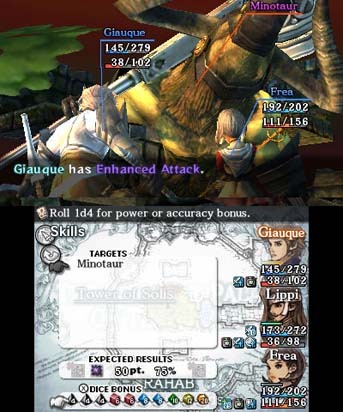Crimson Shroud blends the design from the old-school class of turn-based JRPG with the oldest of the old west(ern style of role-playing games). I’m not talking about Baldur’s Gate or Icewind Dale, either. I’m talking about 20-sided dice, percentage chances and saving throws.
The success of just about everything you do during Crimson Shroud’s otherwise fairly traditional turn-based combat is determined and/or enhanced by using the 3DS touchscreen to roll digital dice. Dice don’t just play a role in the game’s look, however. Starting a combo by repeatedly casting spells of different elements will earn you more dice that can then be added either to your odds of successfully attacking or to the damage dealt by them. But, if you think you can get by without, banking your dice for later will allow you to loot more items at the end of combat.
Further supporting the game’s style is the fact that every character in the game — from NPCs to party members — is represented by a mounted miniature. More important in bringing the style to life than either of those touches is the game’s dedication to narration. The entire story (which is, unfortunately, conveyed entirely without voice acting) is narrated by a sort of disembodied dungeon master in the second-person. Of all the wonderful touches Crimson Shroud includes to set the stage, this is the most effective and endearingly low-tech.
It’s a shame, then, that the story Level 5 decided to tell isn’t very exciting. Our band of heroes is sent off in search of the titular and mysterious Crimson Shroud, rumored to be the source of the magical “gifts” that makes the game’s world go round. Besides a couple of predictable twists and a cliffhanger ending, that’s more or less the entire story. Crimson Shroud isn’t a terribly long game. That’s understandable considering its $8 price tag and status as a Guild01 experiment. That’s not meant as a knock against the game. Crimson Shroud doesn’t try to make you feel like it’s the only game you’ll need all year. It sets up an interesting structure and the tools to play with it, and then wraps up once its tricks have been exhausted. Crimson Shroud knows when its time is up and doesn’t try to claw at your free time for more than you have the patience to offer. That’s something that every RPG could stand to learn.
What really keeps the game concise is the way that it completely circumvents the issue of grinding by ignoring character leveling systems entirely. Regrettably only leads to another. Since stats and magic attacks are tied to gear drops rather than character progression it’s easy to find yourself completely unprepared for enemy encounters. This traps you in the cycle of picking a fight, hoping you have whatever spells will work properly and then either dying or restarting from your last save and trying again with different gear if you found yourself unprepared.
Poking the touchscreen to set virtual d20s tumbling is no more effective than plucking a random integer from thin air. It’s a neat gimmick, but one that can start to feel tedious once you start to think about what you’re actually doing. It’s also painfully obvious that the molded miniature aesthetic and non-voiced story were chosen as much for their cost-effectiveness as nostalgia. It certainly doesn’t help that most of the character models are so poorly rendered that it’s often difficult to make out exactly what they’re supposed to look like. However, none of that makes the player feel any less like a massive nerd scratching charisma bonuses onto a character sheet.
That sense of belonging that only understanding acronyms like GURPS (ahem) can engender has (perhaps justifiably) been missing from games for some time. While Crimson Shroud certainly isn’t Planescape: Torment 2 (ahem), it does feel like a heartfelt attempt at invoking those old feelings in new ways.
On its own, that loop is incredibly frustrating, particularly during boss fights. Delivering further disappointing drudgery is the developer’s baffling decision to make the abilities associated with an item invisible until they’ve been equipped. In order to tell what effect a weapon or piece of armor will have on a party member’s arsenal of spells, you must first enter a menu, equip it, back out, enter another menu and examine the new skill set.
The idea of a short, inexpensive micro-RPG that focuses on replayability through new game+ rather than homogeneous padding is brilliant, and perfectly suited to handhelds like the 3DS and Vita. Unfortunately, Crimson Shroud weighs down its own lean package with too many UI oddities, trial-and-error gameplay and cliched plot points to let its own brilliance soar. The best thing I can say about Crimson Shroud is that in this sequel-driven industry, we probably haven’t seen the last of the ideas on display here. And that is definitely a good thing.
This review is based on a copy of Crimson Shroud provided to SideQuesting by the publisher.





No Comments